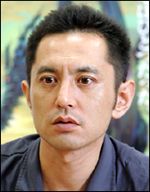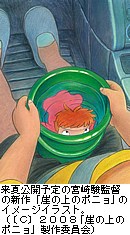English-only Ghibli fans might be interested to know how people are reacting to the recently announced new Ghibli film “Ponyo of the Cliff top”. J-Cast has the story:
Hayao Miyazaki to Re-educate Son with New Film
Mar. 20
Director Hayao Miyazaki’s latest project, “Ponyo of the Cliff Top” was announced yesterday for a summer 2008 release. The main character, a 5-year-old boy named “Sosuke” was modeled after Miyazaki’s son Goro. Goro directed the Ghibli project “Tales of Earthsea” in 2006, and while the film was a major hit, many slammed how the film turned out. As a result, Hayao is attempting to re-educate his eldest son, and has included a message in the film of how he wants his eldest to turn out. Or at least that’s what everyone is saying.
The 5-year-old Lead Resembles Hayao’s Son
 This will be the first film from Hayao Miyazaki ever since Howl’s Moving Castle achieved huge box office totals of 19.6 billion yen when it was released 4 years ago (November 2004). The new film is a story of Ponyo, a goldfish princess who wants to become human, and the five-year-old Sosuke. Producer Toshio Suzuki explains, “This is kind of like Miyazaki’s version of ‘The Little Mermaid.'” Tales of Earthsea, which came out last year, was supposed to have been directed by Hayao himself — he negotiated the film rights with the original author 20 years ago — but the director changed to his eldest son, Goro (pictured). As J-Cast reported earlier:
This will be the first film from Hayao Miyazaki ever since Howl’s Moving Castle achieved huge box office totals of 19.6 billion yen when it was released 4 years ago (November 2004). The new film is a story of Ponyo, a goldfish princess who wants to become human, and the five-year-old Sosuke. Producer Toshio Suzuki explains, “This is kind of like Miyazaki’s version of ‘The Little Mermaid.'” Tales of Earthsea, which came out last year, was supposed to have been directed by Hayao himself — he negotiated the film rights with the original author 20 years ago — but the director changed to his eldest son, Goro (pictured). As J-Cast reported earlier:
“Ghibli’s Suzuki said in an interview ‘(Hayao) said that “it would be inconceivable for Goro to take the helm.” In other words, he was totally against Goro directing it.'”
Afterward, Suzuki convinced Hayao to go along, but while the production ended up being a hit, the movie received less than favorable reviews from viewers and the original author.
The father-son feud was reported as follows in a March 20, 2007 article in Sports Nippon:
“Sosuke was modeled after Goro Miyazaki, Hayao’s 40-year-old eldest son. Goro made his directorial debut with Tales of Earthsea last year, and Hayao interpreted his son’s actions as a rebellion against his father, reportedly expressing remorse: “Things turned out this way because I was working all the time and didn’t spend time with Goro when he was 5 years old. [I’m making this] so there won’t be any more children like Goro.”
It looks like this will be a film about regrets over raising an eldest son.
“Thank goodness it’s Hayao!”
Since Hayao Miyazaki has made several statements indicating he’s retiring from directing, rumors had been circulating on the Internet wondering if there would be another Hayao-directed film. Perhaps influenced by such concerns, there are lots of blog entries from Yahoo, Livedoor, and Excite-hosted blogs placing their hopes in Hayao:
“Thank goodness it’s Hayao!!! But it looks like the kid is modeled after Goro…”
“Yes!!! YES!!!! I LOOOOOOOVEEEE Miyazaki’s movies!! Goro’s movie was just so poorly received I still haven’t watched it [Translator: Same here!], but I wonder how Earthsea turned out? Hayao’s movies almost never fail to please, so I am simply looking forward to it.”
“I am looking forward to this. Since this is coming after Goro Miyazaki seems to have misjudged the public, I am interested to see how people react to this one.”
Will this new film feature the father’s overwhelming dignity and serve to re-educate Goro?
Comment: This looks like a continuation of the human drama initiated and encouraged by Ghibli (who printed Goro’s blog that detailed the feud and an interview with Suzuki that explained more about it) since it was learned that Earthsea would be directed by the inexperienced Goro. Since, as J-Cast notes, Earthsea ended up being a hit despite bad reviews, perhaps the promoters and investors (which include notorious hit-generators Hakuhodo and Dentsu) see this reality-show spectacle as an effective way to generate hype. The personal stories probably resonate with fans of Studio Ghibli, which was voted Japan’s top-ranking brand name in a 2006 poll of consumers conducted by Nikkei BP:
Miyazaki magic
Studio Ghibli stepped up from second place in the 2005 survey, receiving fairly high marks in two of the four categories the survey conductors determined to be key factors in creating brand power. The two categories were friendly and outstanding.
The animation studio has spawned an array of popular films, such as “Howl’s Moving Castle”, released in 2004, successfully connecting with consumers on an emotional basis.
Resonating with consumers is the ultimate goal of corporate marketing.


 I was just wondering why there are is so much news being created by the Japanese right wing, while the hard core left wingers never even seem to make the paper. Since the
I was just wondering why there are is so much news being created by the Japanese right wing, while the hard core left wingers never even seem to make the paper. Since the 



